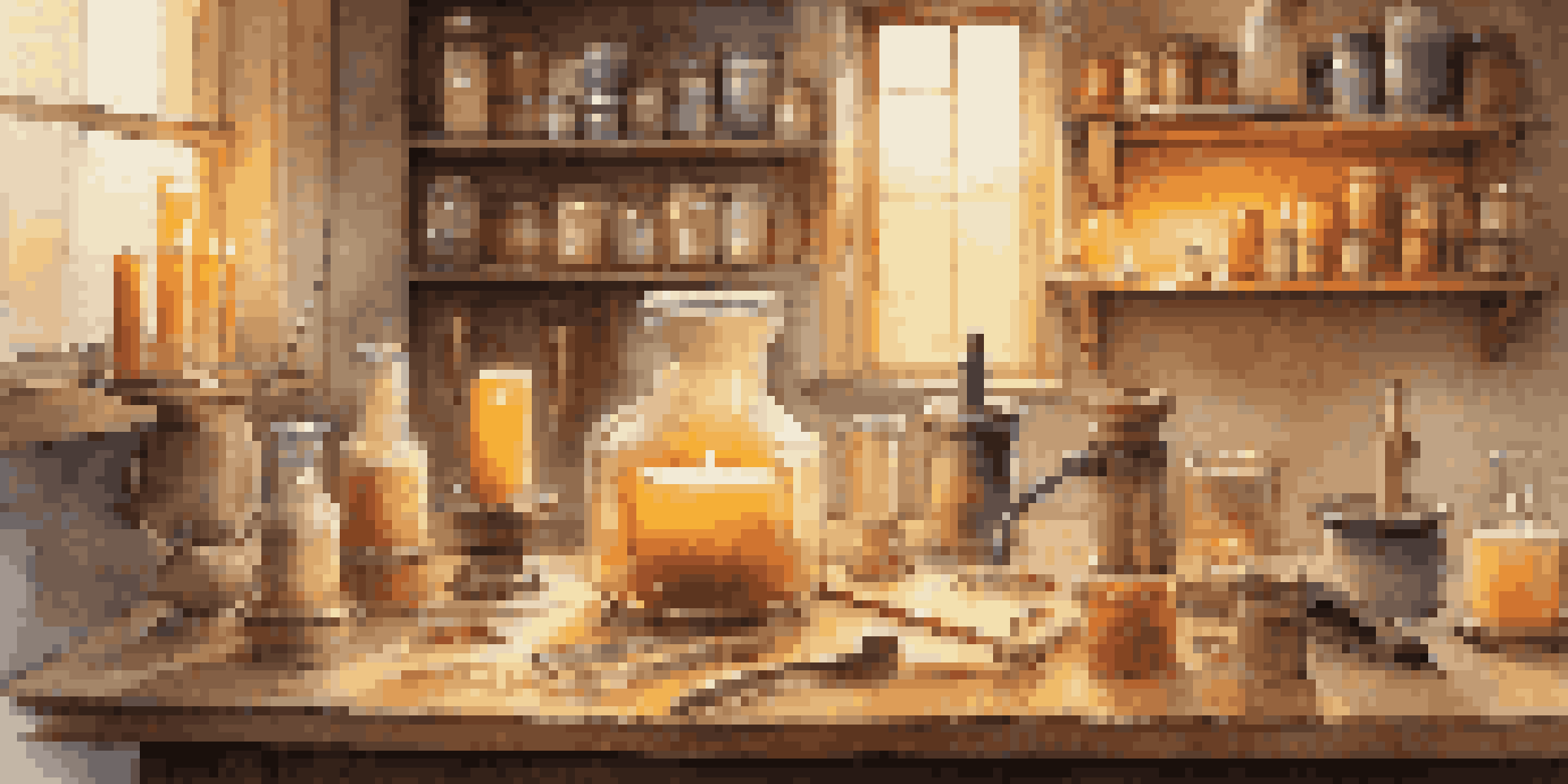The Impact of Temperature on Candle Making and Burning

How Temperature Influences Wax Melting Points
Temperature plays a crucial role in determining the melting point of various candle waxes. Each type of wax, whether it's paraffin, soy, or beeswax, has its own ideal melting temperature that can affect the final product. For instance, soy wax typically melts around 120°F to 180°F, making it essential to monitor the temperature carefully during the candle-making process.
The candle’s light is a reflection of the care and thought that goes into its creation.
If the temperature is too low, the wax may not melt properly, leading to uneven texture and poor scent throw. Conversely, if the temperature is too high, the wax can overheat, which might cause it to lose its fragrance or even develop a burnt smell. Therefore, understanding the melting point of your chosen wax is fundamental for producing high-quality candles.
In essence, managing the melting temperature is the first step in crafting candles that not only look good but also perform well. By keeping an eye on the temperature, you can ensure a smooth, even melt that enhances both the appearance and scent of your candles.
The Importance of Pouring Temperature in Candle Making
Once the wax has melted, the pouring temperature is the next vital factor to consider. Pouring at the right temperature can significantly impact how the candle sets and its overall appearance. For many waxes, the ideal pouring temperature ranges from 140°F to 170°F, but this can vary based on the specific wax type and additives used.

If you pour the wax when it's too hot, you might end up with a rough surface or unsightly air bubbles. On the other hand, pouring too cool can lead to poor adhesion between layers and can create uneven textures. Thus, achieving the right pouring temperature is essential to produce professional-looking candles.
Temperature Affects Wax Melting Point
The melting point of different wax types is crucial for achieving a smooth, even texture and optimal scent throw in candle making.
Ultimately, the right pouring temperature can enhance the candle's aesthetic and functional qualities, leading to a more enjoyable burning experience. Paying attention to this detail can separate a novice candle maker from an expert one.
Cooling Time: How Temperature Affects Candle Hardening
Cooling time is another critical aspect influenced by temperature. After pouring, candles need adequate time to cool and harden properly. The ambient temperature of the room can significantly affect how quickly this occurs; a cooler room will allow the candle to harden more slowly, while a warmer room can accelerate the process.
Candles are the one thing that can turn a house into a home.
If a candle cools too quickly, it may crack or develop unsightly surface flaws, detracting from its overall quality. Conversely, a slow cooling process allows for a more uniform structure and a smoother finish. Therefore, setting up the right environment for your candles to cool is essential for achieving the best results.
In summary, managing cooling time and conditions is crucial for producing candles that look beautiful and burn evenly. Creating a stable environment for your candles to set can lead to a more polished final product.
Effect of Temperature on Scent Throw When Burning
Temperature also plays a pivotal role in how well a candle releases its fragrance when burned. The scent throw refers to how far the fragrance travels from the candle, and it can be heavily influenced by the burning temperature. When a candle burns at the optimal temperature, it can release its scent more effectively, creating a pleasant ambiance in the room.
However, if the temperature is too low, the wax may not melt enough to release the fragrance oils, leaving you with a lackluster scent experience. Conversely, too high a temperature can lead to the scent burning off too quickly, diminishing the overall aroma. Therefore, finding that sweet spot is essential for maximizing your candle's scent throw.
Pouring Temperature Matters
Pouring wax at the correct temperature is essential for preventing surface flaws and ensuring a professional finish.
In essence, understanding how temperature affects scent throw can help candle makers create products that fill a space with delightful aromas and enhance the overall experience. A well-scented candle can make any room feel warm and inviting.
The Impact of Ambient Temperature on Candle Performance
Ambient temperature, or the surrounding temperature in which the candle burns, can greatly influence its performance. For example, burning a candle in a cold room can result in a slower burn, while a warmer environment can cause the candle to burn faster and potentially unevenly. This highlights the importance of considering where you place your candles for optimal performance.
Additionally, extreme temperatures can affect the wax and wick's integrity, leading to issues like tunneling or uneven melting. Tunneling occurs when the wax burns down the center, leaving a wall of unburned wax around the edges. Maintaining a moderate ambient temperature can help prevent these problems and ensure an even burn.
Ultimately, being aware of the impact of ambient temperature can help candle enthusiasts choose the best locations for their candles. This knowledge can lead to a more enjoyable and longer-lasting candle experience.
Choosing the Right Wick for Different Temperatures
The wick you choose plays a significant role in how your candle burns, and its effectiveness can vary with temperature. A wick that works well in one type of wax or temperature may not perform as well in another. For instance, thicker wicks are generally better for hotter-burning candles, while thinner wicks might be suitable for cooler-burning waxes.
Selecting the appropriate wick can help ensure a consistent burn and optimal scent throw. If the wick is too small, it may not create a large enough melt pool, leading to a poor burn and wasted wax. On the other hand, a wick that is too large can create too much heat, causing the candle to burn too quickly.
Ambient Temperature Influences Burns
The ambient temperature can significantly impact how evenly and effectively a candle burns, affecting its overall performance.
In short, understanding the relationship between wick size and temperature can make a significant difference in the performance of your candles. This knowledge is essential for achieving the best results in your candle-making endeavors.
Safety Considerations: Temperature and Candle Burning
Safety should always be a priority when dealing with candles, and temperature plays a significant role in this aspect. Burning candles at too high a temperature can lead to dangerous situations, such as overheating and even fire hazards. It's crucial to keep an eye on the candle while it's lit and ensure it’s placed on a heat-resistant surface.
Furthermore, the type of wax used can also impact safety. Some waxes may emit more soot or potentially harmful chemicals when burned at high temperatures. Therefore, selecting quality wax and maintaining appropriate burning temperatures is vital for a safe candle experience.

Ultimately, being aware of the safety implications of temperature in candle burning can help prevent accidents and ensure a pleasant atmosphere. By taking these precautions, you can enjoy your candles without worry.